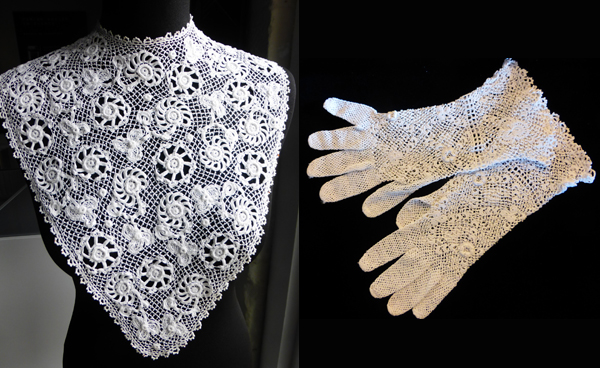The story of Clones lace
Published in Issue 5 (September/October 2019), News, Volume 27By Dianne McPhelim
The Revd and Mrs Cassandra Hand arrived in the small country town of Clones, Co. Monaghan, in October 1847, bringing with them a family of seven children and memories of a comfortable life in England. Born in 1809, the ninth child of the Molyneux family, Cassandra had enjoyed a privileged upbringing in the grand surroundings of Losely Park and Gardens in Guildford, Surrey.
In stark contrast, Ireland was a country ravaged by famine and disease. Successive failures of the potato crop, incredibly harsh winters and a lack of government reaction had resulted in the decimation of villages and towns across the country. Some two hours north of Dublin, the rural environs of Clones Poor Law union was one of the most badly affected in the country, losing some 30% of its population. In this setting of ‘Black ’47’, amidst the poverty and despair, Cassandra Hand arrived to begin a new life.
Various famine relief projects had sprung up around the country and Cassandra, a practical woman, put her energies into developing such a scheme in Clones, to create a source of income for families. Her husband once stated that his wife ‘carried with her a good heart and an anxious desire to be useful’. Inviting teachers from Kildare, she began lacemaking classes in the front room of her home in the townland of Altartate, Clones. Now renamed Bishopscourt House, the Hand family home still stands today. Based on Venetian Point, the stunning Italian lace was very time-consuming to sew, taking around 200 hours for a seven-inch piece. Makers soon adapted their needles into crochet hooks by bending and sticking the needle into a piece of cane or softwood, with bale cord wrapped around the handle to soften it in the hand of the user. These later became known as ‘famine hooks’. The creation of a type of crochet lace drastically reduced the production time and so Clones lace was born.

Above: Clones lace collar (left), c. 1900, maker unknown; lace gloves (right) by Julia Mowen (1885–1970).
Throughout the drumlin hills of Monaghan and south Fermanagh the art of making this intricate Clones lace took hold, and through agents it made its way to the fashion houses of Europe, to be worn by gentry and royalty alike. The lacemakers devised new motifs by taking inspiration from the hedgerows and fields around them, but always retained the grape and vine leaf as an appreciative nod to its Italian origins. Motifs were connected by the distinctive ‘Clones knot’—a ball made by turning the hook ten to twelve times around the fine thread, with hundreds of ‘rolled dots’ within a finished piece. With men and children crocheting also, Clones lace became a life-saving source of income. In 1859 Cassandra Hand raised funds from the lace sales to build a school for infants and young girls. Now a folk museum, the Cassandra Hand Centre, with its beautiful Gothic architecture, is open to visitors. By 1910 Clones was reportedly the centre of lacemaking in Ireland.
Many Clones lace patterns were held as a closely guarded secret within families, but over time lacemaking families emigrated or passed away and the fashion for lace waned. In 1988 local women reinvigorated the craft and launched the Clones Lace Guild, returning Clones lace back to its rightful place in Irish history. Each June visitors from all corners of the globe gather to take part in the annual Lace Summer School, held at the Ulster Canal Stores Visitors Centre.
Known as the traditional home of Clones lace and situated on the banks of the Ulster Canal, this nineteenth-century cut-stone former canal storehouse has been beautifully restored as a visitor centre containing an exhibition of Clones lace, dating back to c. 1880, which includes wedding dresses and collars. The ‘Linked by a Thread’ exhibition is free to view and begins with a short film introducing visitors to the historical background of Clones. The premises have ample parking and full disabled access, with on-site restaurant and nearby playpark.
From its humble origins in the 1850s to the modern pieces of today, the Clones lace story has been irrevocably stitched into the fabric of Irish history.
Dianne McPhelim is Culture and Tourism Officer at Clones Lace Museum.
















